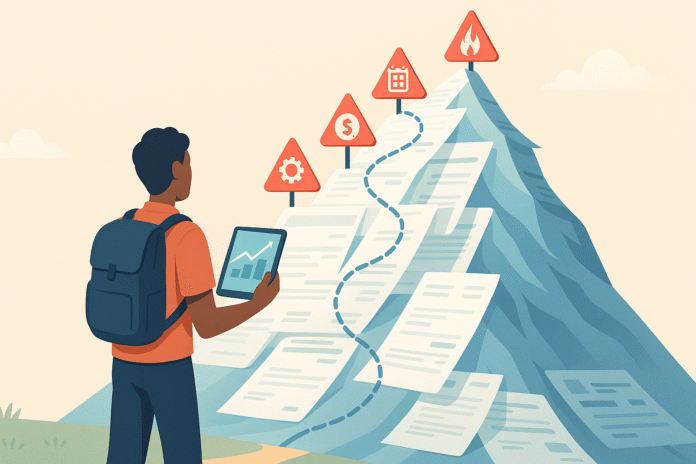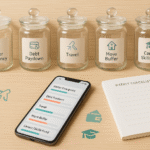If you’re serious about paying off debt efficiently, the debt avalanche method is one of the most powerful tools you can use. It prioritizes your highest-interest balances first, which helps you minimize total interest paid and shorten your payoff timeline. But even the best strategy can backfire if you make a few common missteps. This guide walks you through the top mistakes people make with the debt avalanche method—and exactly how to avoid them—so you can get out of debt faster and with fewer headaches.
Disclaimer: The information in this article is for educational purposes only and is not financial advice. Everyone’s situation is different. Consider consulting a qualified financial professional for personalized guidance.
Key takeaways
- The avalanche works only if your cash flow is stable. Set a small emergency buffer and automate minimums before sending extra to your highest APR.
- Order debts by true cost, not just headline APR. Include fees, promo expirations, variable rates, and compounding rules so your “avalanche order” reflects reality.
- Automation prevents “payment drift.” Fixed, automatic transfers toward your top-priority debt reduce friction and speed progress.
- Motivation matters. Pair the mathematically optimal avalanche with behavioral “small wins” to stay consistent through long payoffs.
- Review monthly. Interest rates and balances change; your plan should, too. Use a quick dashboard to track KPIs and adjust.
Mistake #1: Skipping the Emergency Buffer and Underfunding Minimums
What it is (and why it matters)
The avalanche relies on consistent, uninterrupted extra payments to your highest-interest account. If you don’t have a small buffer for surprises—or you’re barely covering minimums—one flat tire or medical bill can force you to pause, miss a payment, or worse, rely on high-interest credit again. That stalls momentum and can increase costs.
Core benefit of doing it right: With a modest emergency buffer and guaranteed minimums, you insulate your plan from life’s unpredictability. That stability helps the avalanche do what it does best: crush interest.
Requirements and low-cost alternatives
- Emergency buffer target: Start with $500–$1,000 for basic resilience. If your income is irregular or you have dependents, aim higher.
- Autopay minimums: Turn on autopay for every account to avoid late fees and protect your credit.
- Low-cost alternatives: If you can’t save a buffer immediately, temporarily reduce extra avalanche payments to seed the buffer over the next 2–4 paychecks. Keep minimums automated.
Step-by-step setup
- List all debts with balances, APRs, minimums, and due dates.
- Turn on autopay for minimum payments across the board.
- Fund your buffer as quickly as possible (sell unused items, reduce optional expenses, or use a small side gig).
- Start avalanche payments only after the buffer is in place and minimums are automated.
Beginner modifications and progressions
- Beginner: Build a $500 buffer first, then begin the avalanche with modest extra payments (even $25–$50).
- Intermediate: Increase buffer to 1 month of essential expenses; bump your fixed extra payment.
- Advanced: Maintain a 3–6 month buffer while aggressively accelerating debt payments with seasonal income, bonuses, or tax refunds.
Recommended frequency, duration, and metrics
- Frequency: Review cash flow weekly until stable; then monthly.
- Duration: Maintain your buffer throughout the payoff period.
- KPIs: On-time minimums (100%); months-without-missed-payments; days of cash on hand; size of fixed extra payment.
Safety, caveats, and common mistakes
- Do not start avalanche transfers if your minimums aren’t fully covered by autopay.
- Watch for unexpected annual fees or insurance premiums that drain your buffer.
- Avoid raiding the buffer for lifestyle upgrades; it’s for disruptions.
Mini-plan example
- Autopay all minimums today.
- Direct the next two paychecks to build a $750 buffer—pause extra payments until you reach it.
Mistake #2: Sorting Debts Incorrectly (APR Isn’t the Whole Story)
What it is (and why it matters)
The avalanche is built on the idea that you’ll pay least interest overall by focusing on highest-cost debts first. But “highest cost” isn’t just the headline APR. True cost also reflects fees, compounding rules, variable-rate resets, and promotional expirations. Sort incorrectly and you may accidentally keep a costlier debt around longer than necessary.
Core benefit of doing it right: Precise ordering maximizes the avalanche’s mathematical advantage—saving money and time.
Requirements and low-cost alternatives
Collect these details for each debt:
- APR and whether it’s variable.
- Compounding (daily vs. monthly; daily compounding grows interest faster).
- Fees (annual, late, over-limit, “paper statement,” balance transfer).
- Promos (0% periods, expiration dates, deferred interest language).
- Grace period and daily periodic rate (APR ÷ 365) if available.
Low-cost alternative: If documents are hard to find, call the issuer or check your online portal. A 10-minute call can reveal fees or promo terms that drastically change your payoff order.
Step-by-step ordering method
- Build a debt sheet with: name, balance, APR, daily periodic rate, fees, promo expiration, variable rate index/margin.
- Calculate “effective priority score.” Start with APR, then add a fee-adjusted bump (e.g., if an annual fee is due within 3 months, treat APR as if +1–2 percentage points), and elevate any debt with a promo ending in the next 1–3 cycles.
- Sort by priority score highest to lowest.
- Re-run this ordering monthly; update for rate moves, new fees, or promos ending.
Beginner modifications and progressions
- Beginner: Sort by APR only to start; add fee/promo adjustments later.
- Intermediate: Include compounding and promo end dates in a simple scoring rule.
- Advanced: Model scenarios (e.g., balance transfer vs. keep-and-pay) and pick the lowest total interest path.
Recommended frequency, duration, and metrics
- Frequency: Recalculate order monthly; immediately when a promo is about to end.
- KPIs: Number of debts in correct order; months saved (vs. snowball or naive ordering); total interest forecast vs. actual.
Safety, caveats, and common mistakes
- Watch for deferred interest promotions on retail cards: if a balance remains at expiration, all back interest may apply.
- Variable-rate cards can jump if benchmark rates or issuer margins change.
- Annual fees effectively raise your cost—treat them as an APR upgrade when prioritizing.
Mini-plan example
- List debts and add promo end dates and fees.
- Move any debt with a promo ending within 60 days to the top of the avalanche, even if its current APR is lower.
Mistake #3: Relying on Willpower Instead of Automation
What it is (and why it matters)
Manually deciding how much extra to pay each month invites decision fatigue and “payment drift.” Life gets busy, and those hard-won dollars can easily get diverted to something else. Automation converts intention into consistent action—no calendar reminders required.
Core benefit of doing it right: Fixed, automatic extra payments to your top-priority debt raise your payoff speed and reduce mental load.
Requirements and low-cost alternatives
- Bank bill pay or card autopay: Use your bank’s recurring transfer to the specific account.
- Fixed extra amount: Pick a sustainable extra payment (e.g., $150/month) rather than a fluctuating one.
- Rollover rule: When your top debt is eliminated, roll the entire payment to the next priority automatically.
Low-cost alternative: If automation isn’t available, schedule recurring calendar events with the exact transfer amount and account number. Treat it like a non-negotiable bill.
Step-by-step automation
- Confirm all minimums are on autopay.
- Set one recurring extra payment every payday to the highest-priority debt.
- Create a “debt rollover” reminder in your calendar for the anticipated payoff month to redirect the full payment to the next debt.
Beginner modifications and progressions
- Beginner: Start with $25–$50 extra per month—automated.
- Intermediate: Increase the extra payment by a fixed percentage of any raise (e.g., 50% of each pay bump).
- Advanced: Add biweekly automation (half-payment every two weeks often feels easier) and sweep side-hustle income monthly.
Recommended frequency, duration, and metrics
- Frequency: Set and forget, then revisit monthly.
- KPIs: On-time automated transfers; extra dollars applied year-to-date; interest saved vs. making minimums only.
Safety, caveats, and common mistakes
- Ensure payday aligns with the transfer to avoid overdrafts.
- Adjust for seasonal expenses (holidays, car insurance). Don’t cancel; reduce temporarily if needed, then restore.
Mini-plan example
- Automate an extra $100 to your top-priority card on the day after payday.
- Add a calendar reminder: “When Card A hits $0, redirect $100 + Card A’s minimum to Card B.”
Mistake #4: Ignoring Motivation—Avalanche Is Math, You Are Human
What it is (and why it matters)
The avalanche is mathematically optimal, but real humans need momentum and feedback. Big, high-interest balances can take months to budge. If you feel like nothing is happening, it’s easy to abandon ship. Smart borrowers combine avalanche efficiency with behavioral “small wins” so motivation stays high.
Core benefit of doing it right: You keep the cost-minimizing power of the avalanche while harnessing psychology to stay consistent.
Requirements and low-cost alternatives
- Visual trackers: A whiteboard, spreadsheet, or app that shows interest saved and balance reductions.
- Milestone design: Plan quick wins that don’t meaningfully reduce avalanche efficiency, such as clearing a tiny balance early to free up a payment.
- Accountability: A friend, community, or periodic check-in.
Low-cost alternative: Use a free spreadsheet with color-coded progress bars and automatic interest calculations.
Step-by-step motivation layering
- Identify one very small balance (e.g., a $120 store card) that minimally affects total interest.
- Pay it off quickly to create a win and eliminate a due date, then return to strict avalanche order.
- Track total interest saved and months shaved off your payoff date; celebrate each milestone.
Beginner modifications and progressions
- Beginner: One tiny balance cleared early for momentum.
- Intermediate: Add gamification (weekly streaks, visual “thermometer,” challenge jars).
- Advanced: Quarterly “debt sprints”—temporarily boost extra payments for 2–4 weeks with a defined prize (free but meaningful, e.g., a hike day or at-home spa night).
Recommended frequency, duration, and metrics
- Frequency: Weekly progress check; monthly milestone review.
- KPIs: Number of on-time payments; streak length; smallest balance removed; months ahead of schedule.
Safety, caveats, and common mistakes
- Don’t reorder large balances for motivation if it significantly increases interest costs. Keep wins small and strategic.
- Avoid conflating “celebration” with overspending. Choose free rewards.
Mini-plan example
- Clear your $95 retail card this week to simplify your due dates.
- Revert immediately to your highest-APR debt with all freed-up dollars.
Mistake #5: “Set It and Forget It”—Not Reviewing as Rates and Rules Change
What it is (and why it matters)
Interest rates move, issuers change margins, promos expire, and fees show up. If you never recalculate your avalanche order, you might be paying extra on the wrong account or missing a cheaper path like a responsible balance transfer or refinance. A quick monthly review keeps your plan aligned with reality.
Core benefit of doing it right: You keep the avalanche’s edge by adapting to new information—saving more and finishing sooner.
Requirements and low-cost alternatives
- Monthly review ritual: 15–20 minutes on the same date each month.
- Interest-rate watch: Check APRs, promo clocks, and any issuer notices.
- Options file: Note potential moves (0% balance transfer offers, consolidation loans, hardship programs).
Low-cost alternative: Use your phone’s reminders plus a single spreadsheet tab called “Month Review.”
Step-by-step monthly review
- Update balances and APRs; verify any fees posted.
- Reorder debts if a promo is within 60 days of expiring or a variable rate jumped.
- Evaluate options: Would a balance transfer or refinance lower total cost without risky trade-offs?
- Adjust automation to match the updated order.
Beginner modifications and progressions
- Beginner: Monthly check for promo expirations only.
- Intermediate: Add rate-change tracking and interest forecast comparisons.
- Advanced: Quarterly what-if scenarios (e.g., add $50 to extra payment; accept a transfer offer; consolidate two loans).
Recommended frequency, duration, and metrics
- Frequency: Monthly; immediately upon issuer notices or promo changes.
- KPIs: Interest saved vs. baseline; months remaining; number of rate/promo changes captured before they cost you.
Safety, caveats, and common mistakes
- Balance transfers are powerful but not magic: watch for transfer fees, deferred interest, and promo windows.
- Avoid consolidations that extend your term so long that total interest rises—even if monthly payments drop.
- Never close old cards solely for tidiness without checking credit utilization impacts.
Mini-plan example
- On the first Saturday of each month, update your sheet and reorder if needed.
- If a promo ends within 60 days, move that account to the top and consider a low-fee transfer—only if it clearly lowers total interest.
Quick-Start Checklist
- Autopay minimums on every account.
- Build a $500–$1,000 emergency buffer (more if income is variable).
- List debts with APR, fees, promos, compounding, and due dates.
- Sort by true cost (adjust APR for fees and promos).
- Automate one fixed extra payment to your top-priority debt.
- Add a monthly review reminder; update order and automation.
- Track interest saved, months remaining, and streaks.
Troubleshooting & Common Pitfalls
- “My promo expired and my APR jumped.” Reorder immediately; evaluate balance transfer only if after fees you still pay less overall.
- “I can only spare $25 extra some months.” Automate the $25 to keep your streak; send windfalls separately. Consistency beats intensity.
- “Unexpected bill wiped out my progress.” Pause extra payments, rebuild the buffer, then resume. Don’t let one setback derail the plan.
- “I’m losing steam.” Insert one tiny quick win (clear a $50–$150 balance) to regain momentum—then return to the avalanche order.
- “Should I refinance?” Compare total interest with fees and term length. If a lower effective rate and similar or shorter term reduce total interest, it’s worth considering.
- “I’m juggling due dates.” Ask issuers to change due dates to cluster around payday; fewer dates = fewer mistakes.
How to Measure Progress (Simple Metrics That Matter)
- Interest saved vs. minimums-only: Your plan should show growing savings as balances fall.
- Debt-free date: Update this monthly; aim to pull it forward in small increments.
- Payment streaks: Count consecutive on-time payments and automated transfers.
- Utilization ratio: As balances drop, keep an eye on revolving utilization (balance ÷ credit limit).
- Number of accounts closed or simplified: Fewer due dates reduce errors and stress.
Tip: Track just three numbers on a whiteboard or phone widget: interest saved YTD, months remaining, streak length.
A Simple 4-Week Starter Plan
Week 1: Foundations
- Turn on autopay minimums for every account.
- Build a $500 buffer using a tight weekly budget.
- List debts, APRs, fees, promos, and due dates.
Week 2: Sort & Automate
- Create your avalanche order (adjust APRs for fees/promos).
- Automate a fixed extra payment (even $25–$100) to the top debt.
- Set a monthly review reminder.
Week 3: Quick Win (Optional but Helpful)
- If you have a tiny balance that doesn’t materially hurt your avalanche efficiency, pay it off to create momentum.
- Update your tracker; celebrate with a free reward.
Week 4: Tune & Protect
- Revisit your order; confirm automation works.
- Add one “friction reducer” (e.g., align due dates with payday, unsubscribe from shopping emails, freeze a card if overspending is a risk).
- Record KPIs: interest saved estimate, months remaining, and streak length.
Repeat the cycle monthly: review, adjust, automate, and track.
FAQs
1) What’s the difference between the debt avalanche and the debt snowball?
Avalanche targets the highest APR first to minimize total interest; snowball targets the smallest balance first to maximize motivation. Avalanche usually costs less overall, while snowball can feel faster psychologically on early wins.
2) How big should my emergency buffer be before I start?
A $500–$1,000 starter buffer works for many households. If your income is variable or you support dependents, aim higher before accelerating extra payments.
3) Should I ever pay off a small balance first when using avalanche?
Yes—strategically. Clearing a tiny balance can free a due date and create momentum, as long as it doesn’t meaningfully increase overall interest costs. Then return to strict avalanche order.
4) How often should I reorder my debts?
Do a monthly review and whenever a promo is within 60 days of expiring or a variable APR changes.
5) Are balance transfer cards a good idea for avalanche users?
Potentially. If the transfer fee + promo terms lead to lower total interest and you can pay off within the promo window, it can accelerate progress. Avoid offers with tricky deferred interest or high go-to rates if you’ll carry a balance past the promo.
6) What if I can’t automate extra payments?
Set calendar reminders and treat the extra payment like rent—non-negotiable. Consistency matters more than the amount at first.
7) How do I handle deferred interest promos from store cards?
Prioritize them before expiration. If any balance remains at the end, you could be charged retroactive interest. Consider moving that debt to the top of your avalanche as the date approaches.
8) Will closing paid-off cards help me?
Not necessarily. Closing a card can increase your utilization and potentially lower your credit score. Consider leaving no-fee cards open, but ensure you’re not tempted to overspend.
9) How much extra should I pay each month?
Pick a sustainable fixed amount you can automate. Even $25–$50 builds momentum. Increase it when income rises or expenses drop.
10) What if all my APRs are similar?
Then balance size and fees become tie-breakers. You’ll get similar results regardless of order, so emphasize automation and consistency.
11) Does avalanche still make sense when interest rates are high overall?
Yes. In high-rate environments, the savings from prioritizing the highest APR are often even more meaningful. Your review cadence just becomes more important.
12) How do I stay motivated during a long payoff?
Use visual trackers, celebrate free milestones, and occasionally clear a very small balance for a quick win without undermining the avalanche’s efficiency.
Conclusion
The debt avalanche method can help you pay less interest and get out of debt sooner—but only if you execute it with stability, precision, and consistency. Build a small buffer, automate minimums and extra payments, sort debts by their true cost, keep your motivation high with smart “small wins,” and review monthly as rates and promos change. Do that, and your avalanche won’t just move; it’ll roar.
CTA: Start today—automate one extra payment to your highest-APR balance and set a 15-minute monthly review on your calendar.
References
- How to reduce your debt, Consumer Financial Protection Bureau, July 16, 2019, https://www.consumerfinance.gov/about-us/blog/how-reduce-your-debt/
- Reducing debt worksheet (Tool 3), Consumer Financial Protection Bureau, 2014, https://files.consumerfinance.gov/f/201405_cfpb_your-money-your-goals_dealing-with-debt.pdf
- Your Money, Your Goals: A financial empowerment toolkit (Module 6: Dealing with Debt), Consumer Financial Protection Bureau, June 1, 2020, https://files.consumerfinance.gov/f/documents/cfpb_your-money-your-goals_financial-empowerment_toolkit.pdf
- Debt action plan tool, Consumer Financial Protection Bureau, 2018, https://files.consumerfinance.gov/f/documents/cfpb_your-money-your-goals_debt-action-plan_tool_2018-11.pdf
- Understanding minimum payments, Consumer Financial Protection Bureau, updated July 14, 2022, https://www.consumerfinance.gov/consumer-tools/educator-tools/youth-financial-education/teach/activities/understanding-minimum-payments/
- Household Debt and Credit Report (Q2 2025), Federal Reserve Bank of New York – Center for Microeconomic Data, August 3, 2025, https://www.newyorkfed.org/microeconomics/hhdc and PDF: https://www.newyorkfed.org/medialibrary/interactives/householdcredit/data/pdf/HHDC_2025Q2
- Consumer Credit – G.19 (current release), Board of Governors of the Federal Reserve System, Release date August 7, 2025, https://www.federalreserve.gov/releases/g19/current/
- H.15 – Selected Interest Rates (Daily), Board of Governors of the Federal Reserve System, accessed August 14, 2025, https://www.federalreserve.gov/releases/h15/
- Average Credit Card Interest Rate for August 2025, Investopedia, updated August 2025, https://www.investopedia.com/average-credit-card-interest-rate-5076674
- What Is the Average Credit Card Interest Rate This Week?, Forbes Advisor, updated August 2025, https://www.forbes.com/advisor/credit-cards/average-credit-card-interest-rate/
- The ‘snowball approach’ to debt, Kellogg School of Management (Kellogg Insight News), August 7, 2012, https://www.kellogg.northwestern.edu/news_articles/2012/snowball-approach.aspx
- To Beat Debt, Consider Starting Small, Kellogg Insight, January 8, 2014, https://insight.kellogg.northwestern.edu/article/to_beat_debt_consider_starting_small
- How to Avoid or Break the Debt Trap Cycle, Financial Readiness (U.S. DoD), accessed August 14, 2025, https://finred.usalearning.gov/Money/DebtTraps






